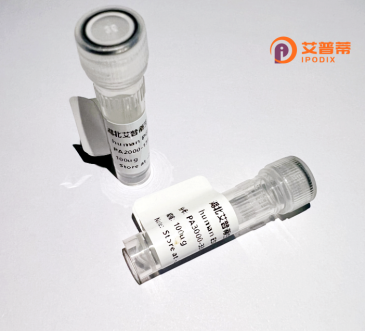
| 纯度 | >90%SDS-PAGE. |
| 种属 | Human |
| 靶点 | APOBEC3H |
| Uniprot No | Q6NTF7 |
| 内毒素 | < 0.01EU/μg |
| 表达宿主 | E.coli |
| 表达区间 | 1-200aa |
| 氨基酸序列 | MALLTAETFR LQFNNKRRLR RPYYPRKALL CYQLTPQNGS TPTRGYFENK KKCHAEICFI NEIKSMGLDE TQCYQVTCYL TWSPCSSCAW ELVDFIKAHD HLNLGIFASR LYYHWCKPQQ KGLRLLCGSQ VPVEVMGFPK FADCWENFVD HEKPLSFNPY KMLEELDKNS RAIKRRLERI KIPGVRAQGR YMDILCDAEV |
| 分子量 | 23.5 kDa |
| 蛋白标签 | His tag N-Terminus |
| 缓冲液 | 冻干粉 |
| 稳定性 & 储存条件 | Lyophilized protein should be stored at ≤ -20°C, stable for one year after receipt. Reconstituted protein solution can be stored at 2-8°C for 2-7 days. Aliquots of reconstituted samples are stable at ≤ -20°C for 3 months. |
| 复溶 | Always centrifuge tubes before opening.Do not mix by vortex or pipetting. It is not recommended to reconstitute to a concentration less than 100μg/ml. Dissolve the lyophilized protein in distilled water. Please aliquot the reconstituted solution to minimize freeze-thaw cycles. |
以下是与重组人编辑酶 APOBEC3H 相关的参考文献及其摘要总结:
---
1. **"Crystal Structure of APOBEC3H Reveals a Unique Fold and a Flexible Active Site"**
*Authors: Rezaei, S. et al.*
**摘要**:该研究通过X射线晶体学解析了APOBEC3H的三维结构,揭示了其独特的折叠方式及活性位点的柔性特征,为理解其与病毒RNA/DNA底物的结合机制提供了结构基础。
2. **"APOBEC3H Subcellular Localization Determines Its Antiviral Activity against HIV-1"**
*Authors: OhAinle, M. et al.*
**摘要**:研究发现APOBEC3H的抗HIV-1活性依赖于其在细胞内的定位,其天然核质分布增强了抗病毒效果,而病毒蛋白Vif通过促进其泛素化降解削弱其功能。
3. **"Genetic Variation of APOBEC3H Impacts Viral Resistance and Clinical Outcomes in HIV Infection"**
*Authors: Kidd, J.M. et al.*
**摘要**:文章指出APOBEC3H的基因多态性(如单核苷酸变异rs13062378)显著影响其蛋白质稳定性及对HIV-1的限制能力,不同等位基因携带者的临床预后存在差异。
4. **"APOBEC3H Inhibits Retrotransposition of Endogenous Retroviruses through Deamination-Independent Mechanisms"**
*Authors: Ito, F. et al.*
**摘要**:研究证明APOBEC3H通过非脱氨基依赖的方式抑制内源性逆转录病毒(如LINE-1)的转座活性,提示其多功能的抗逆转录元件作用。
---
以上文献涵盖结构解析、抗病毒机制、基因多态性以及广谱逆转录抑制功能,反映了APOBEC3H研究的多维视角。如需更多细节或全文链接建议通过PubMed/Google Scholar检索。
APOBEC3H (apolipoprotein B mRNA-editing enzyme catalytic polypeptide-like 3H) is a member of the APOBEC protein family, which plays critical roles in innate immunity by restricting viral infections and maintaining genome integrity. These enzymes function as cytidine deaminases, introducing mutations in viral DNA or RNA by converting cytosine to uracil during replication. APOBEC3H specifically targets single-stranded DNA, making it a potent inhibitor of retroviruses like HIV-1 and retrotransposons.
Human APOBEC3H exhibits genetic polymorphisms that influence its protein stability and antiviral activity. Certain haplotypes encode stable, high-activity variants that effectively suppress HIV-1. while unstable variants offer reduced protection. This functional diversity has implications for interindividual differences in viral defense and disease progression.
Beyond antiviral roles, APOBEC3H has been linked to cancer mutagenesis. Its overexpression in tumors can induce clustered DNA mutations (e.g., kataegis), contributing to genetic instability and oncogenesis. However, its physiological regulation and activity in non-pathological contexts remain less understood.
Recent studies focus on resolving its structural mechanisms, host co-factor interactions, and viral counterstrategies (e.g., HIV-1 Vif-mediated degradation). Understanding APOBEC3H’s dual roles in immunity and disease highlights its potential as a therapeutic target or biomarker, though balancing its protective and mutagenic effects remains a key challenge.
×